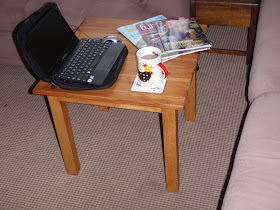After much research and deliberation I have finally got myself a shiny new and very large Tenon Saw.
For 'ages' I have felt like I have needed something bigger than my Lie Nielson Carcass & Dovetail Saws, but I couldn't decide on the size or whether it should be sharpened Crosscut or Rip.
 As far as size goes, it seems the wood working superstars recommend something at least 14" and preferably larger.
As far as size goes, it seems the wood working superstars recommend something at least 14" and preferably larger.
Most of my cutting is to length and therefore requires a Crosscut sharpened saw but larger tenons require a Rip sharpened saw and my Dovetail saw blade is only 1-5/8" (4.12cm) deep. I certainly didn't want to buy another two saws, so which saw would provide the best coverage and compliment my existing joinery saws?
I came to the conclusion that I should get a Rip sharpened saw which could also be used across the grain if required and decided on the Lie Nielson 16" (400mm) 11ppi Tenon saw (reviewed here).
As I found previously, I had to spend a while learning to use the new saw as it initially jumped about in the kerf. This is a large saw and a lot heavier than what I'm currently used to. The weight, combined with the extra height of your hand above the cut (blade depth) and the angle of the (dangle) handle mean't I had to saw very slowly and steadily not applying any downward pressure at all other than the natural weight of the saw while my body became familiar with the movement. After quite a few rip cuts in some scrap Pine I finally got the hang of it, and found the saw to cut fast and track straight as an arrow. No doubt I will further improve the more I use the saw.
I was also pleasantly surprised at how smooth cutting the saw was when cutting across the grain, I will certainly be able to cut wider and thicker boards to length on the bench hook when my Carcass saw is struggling. Anything that is to big for this new 16" beast can then be handled with my panel saws.
 So ... all in all I feel it has been a good purchase and my 'Trinity' of Joinery saws should encompass all my needs, probably for the rest of my life! In fact I would say that my 'nest of saws' is now complete.
So ... all in all I feel it has been a good purchase and my 'Trinity' of Joinery saws should encompass all my needs, probably for the rest of my life! In fact I would say that my 'nest of saws' is now complete.
I would be very interested in other peoples opinions on my purchase and what saws other people use.
An afternoon of boredom led me to find a use for some kitchen surface 'chip board' and some old reclaimed pieces of Pine to make a quick and dirty bench side saw stand. It's not pretty but it did get my freshly sharpened saws off the floor and out of harms way.
Other new additions to the tool collection, once again courtesy of my girlfriends mum. These include two Marples chisels 1" & 1.5", the larger of which is very rusty. I will probably use these for jobs such as cleaning off dried glue etc. saving my Stanley chisels for 'best'. I'd love some Lie Nielson chisels one day they look gorgeous!
A fret saw (needs de-rusting) and pad saw (no blade) and a small mallet. The mallet head is actually made of a 'roll of wood' and will make a good 'assembly' hammer.
Anyway that's enough for now... time to build something soon!














